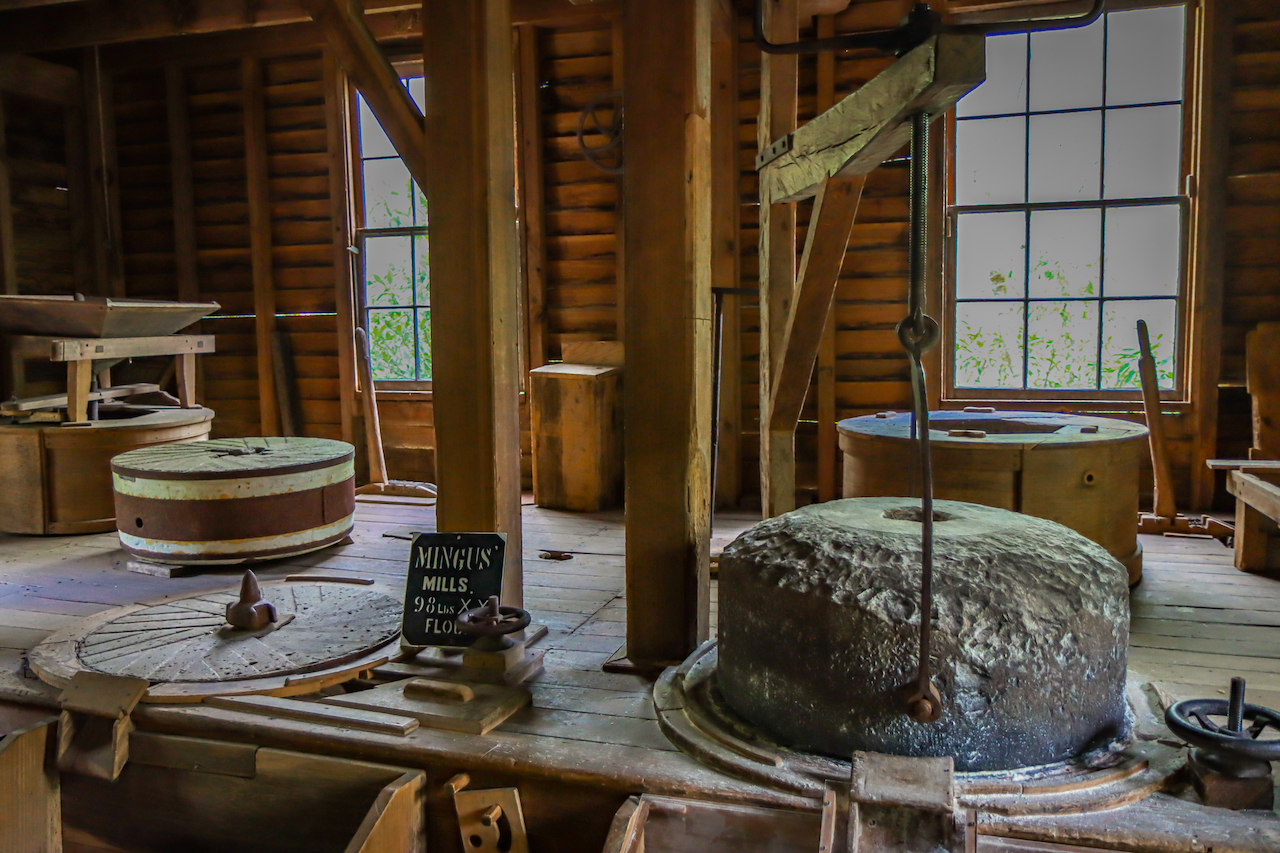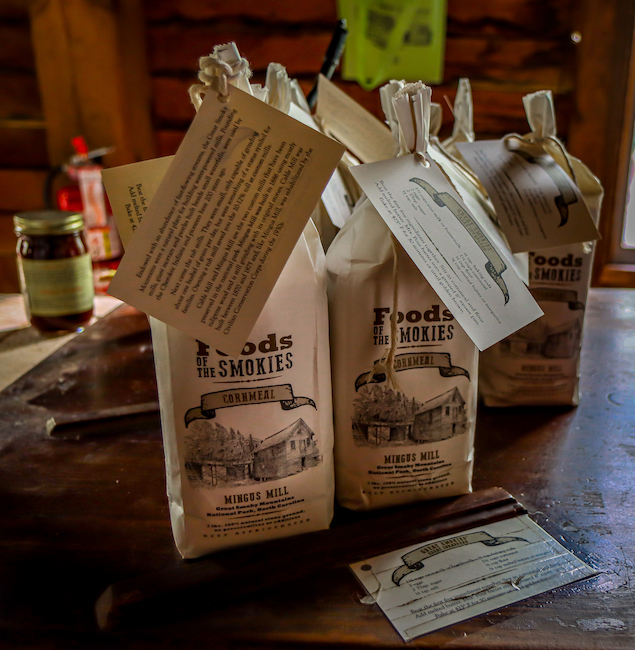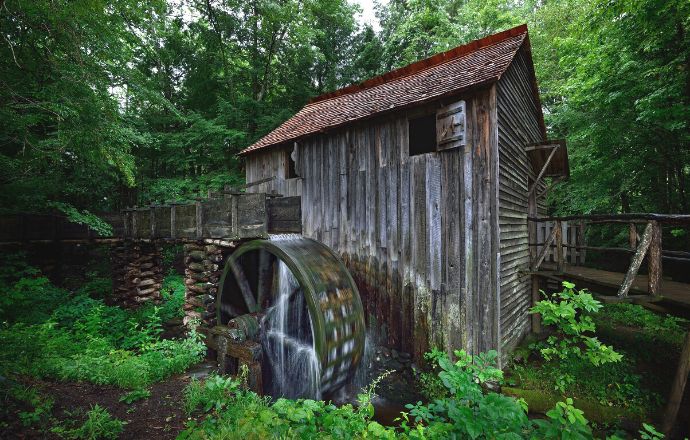With the endless array of things to do in Great Smoky Mountains National Park, it can be difficult to figure out which activities and attractions to prioritize.
If you’re even remotely interested in the history of the Appalachian range, don’t miss a chance at visiting Mingus Mill in NC.
Located just 4 miles north of Cherokee, Mingus Mill is among the more famous historic mills in North Carolina, and one of four old mills you can visit in the Smoky Mountains.
With the region’s extensive array of creeks and waterfalls, it’s no surprise that the grist mills in NC are so numerous.
But Mingus Mill is one of the most impressive and largest actively working North Carolina mills, not to mention one of our favorite historic sites in Western NC.
It’s also a great place for anyone enamored by pretty forests and wildflowers, keen to take a challenging (yet rewarding) hike, or wanting to immerse themselves in a little bit of well-preserved history.
Read on for our in-depth guide to visiting Mingus Mill, including info on driving directions, the history of the mill, hiking the Mingus Mill Trail, and more.
READ MORE: The 15 Best Things to Do in Cherokee NC & the Qualla Boundary

Mingus Mill Info
ADDRESS: Mingus Creek Trail, Cherokee NC, 28719
PHONE NUMBER: 828-497-1904 (Oconaluftee Visitor Center)
HOURS: 9AM -5PM daily, from mid-March through mid-November
Directions from Downtown Cherokee
From downtown Cherokee NC, take US-441 N/Newfound Gap Road.
When you pass the Oconaluftee Visitor Center on the right, go another 0.7 miles and you’ll see the entrance to Mingus Mill on your left.
Directions from Asheville
Head out of Asheville on I-240 West. In 1.7 miles, keep right at the fork to continue onto I-26 E. In 3.2 miles, take exit 31B to merge onto I-40 W.
After 18.3 miles, stay in the right 2 lanes to take exit US-74 US-19/US 23/Clyde/Waynesville/Maggie Valley/Franklin/Murphy/Atlanta.
In about 4 miles, take exit 103 onto US-19 toward Maggie Valley/Cherokee. In 0.4 miles, continue onto US-19 S/Dellwood Rd/Dellwood City Rd. Then, in 4.8 miles, continue straight onto US-19 S/Soco Rd.
Stay on this road for 18.9 miles before turning right onto Acquoni Rd. In 0.6 miles you’ll come to a traffic circle. Continue straight at the traffic circle to stay on Acquoni Rd. In 1.2 miles, turn right onto US-441 N.
When you pass the Oconaluftee Visitor Center, go another 0.7 miles and Mingus Mill will be on your left.
READ MORE; The Top 15 Treehouse Rentals near Asheville NC

Mingus Mill History
The Mingus Mill that can be visited today is believed by historians to be the second mill built on the Mingus family property.
Construction of the mill was completed in 1886 (21 years after the Civil War ended), and it was fully restored by the US National Park Service in 1968.
Funded by Dr. John Mingus (the great-grandfather of North Carolina music legend Charles Mingus), the mill was designed and built by Virginia-bred millwright Sion Thomas Early.
Constructed primarily from the wood of tulip trees, Mingus Mill was the largest grist mill in the Smokies, and is said to have served over 200 local families in its heyday.
Grist is basically another word for grain– typically cereal grains such as wheat, but corn was milled there, too.
On Saturdays, nearby residents would bring their grist to have the miller grind it for them while they chatted with friends and family and caught up on local gossip.
People would also bring the fruits of their labors to trade with other customers while they were waiting for the miller to do their work.
In short, Mingus Mill (and other NC grist mills) became a center of the community, both in terms of commerce and socializing.
READ MORE: 10 Best Cherokee NC Restaurants for Breakfast, Lunch & Dinner

The Working of the Mingus Mill
Mingus Mill became so important and successful because it used a steel turbine to power the mill’s stones and machinery, rather than the more commonly used wooden wheel.
If you head just past the mill to the back of the millrace, you can see where water from Mingus Creek feeds into the flume-like millrace.
It channels the water downhill so that it gradually picks up speed.
The water is filtered along the way in order to remove any leaves, twigs, or grit before it reaches the turbine.
Eventually the water reaches a 22-foot drop, where it pours into a reservoir known as the “penstock.” Then it’s channeled through a steel pipe and on into the mechanisms of the turbine.
The water turns the blades of the turbine, which turns the massive millstones in the mill house above to grind the grist into flour, cornmeal, etc.
READ MORE: The 15 Best Cabins in Cherokee NC for Rent

Mingus Mill Today
In recent years Mingus Mill has become one of the most popular Smoky Mountains attractions, not to mention one of the most frequently visited grist mills in NC.
Today, visitors to the National Park can see the workings of the grist mill for themselves, both from the outside and from within.
Stepping inside the grist mill house during opening hours, you may get a chance to witness the milling process in action.
An on-duty miller will give you a demonstration, and answer any questions you have about Mingus Mill history.
You will also find Mingus Mill cornmeal for sale as well as other local products such as jams and jellies.
If you want a taste of authentic Appalachian culture, try making the Mingus Mill cornbread recipe!
READ MORE: 10 Great Train Rides in North Carolina

Hiking the Mingus Creek Trail
Trailhead: Mingus Mill Parking Lot
Distance: 5.8 miles
If you’re interested in spending more time exploring Mingus Mill, the parking lot is home to a trailhead for one of the best hiking trails in Cherokee NC.
The 5.8-mile Mingus Creek Trail is considered a fairly strenuous hike with 1500+ feet of elevation gain.
Depending on the time of year you visit, this gorgeous grist mill trail has you hiking along a stunning creek dotted with patches of colorful North Carolina wildflowers.
Wooden bridges will have you crisscrossing Mingus Creek several times over the course of the hike. At about 2.9 miles you’ll reach Deeplow Gap, where you can stop for a rest before heading back to the parking lot.
But if you’re a hardy hiker and come prepared with all the necessary hiking essentials, you could continue for another 2.8 miles and trek all the way to Newton Bald!
There’s also an opportunity to pay your respects at a secluded cemetery that was used enslaved people.
It is not clear who was buried here, as there are no headstones (just markers). But the land belonged to the Mingus, Enloe, and Floyd families.
Known as the Enloe Slave Graveyard, this small cemetery can be reached by taking the worn path up to the right after you pass the gate of the trailhead. The cemetery is located less than 100 feet up the path.
READ MORE: The 20 Best Places to Visit in North Carolina
Other Mills in Great Smoky Mountains National Park

Cable Mill at Cades Cove
If you want to see more historic mills in Great Smoky Mountains National Park, head to Cades Cove in Tennessee to visit Cable Mill.
Built by John Cable in 1867, Cable Mill was an invaluable resource for the homesteaders who would bring their grist to be ground. Not only did they mill wheat into flour, but it was also used as a lumber mill.
A fast-moving mountain stream hits the 11-foot water wheel at the top, forcing the wheel around. This is called an overshot mill, as opposed to undershot mills, where the water hits the bottom of the wheel.
Visitors can see one of the Smokies’ most fascinating working mills in action from spring through autumn.
Cades Cove itself is one of our favorite places to visit. It’s an open valley that allows visitors to see local flora and fauna as well as a number of historical buildings, including churches, barns, and log cabins.
There are also trailheads that lead you to some stunning Smoky Mountain waterfalls!
READ MORE: The 15 Best Great Smoky Mountains Campgrounds to Visit

Alfred Reagan Tub Mill
For more grist mills, check out the Alfred Reagan Tub Mill, which was built in 1895.
Located in the Roaring Fork Historic District of Tennessee, the grist mill at this site is what’s called a tub mill (or turbine mill).
This means that the water is channeled to hit a wheel that is mounted horizontally, rather than vertically .
The Reagan Mill is quite small, and would have only been able to mill a bushel of grain at a time.
But when other Tennessee mills didn’t have sufficient power to turn their wheels due to low water levels, it is said that the Reagan wheel always kept on turning!
READ MORE: 20 Best Things to Do in Bryson City NC & Swain County

Ogle Mill
If you’re still looking for things to see in Great Smoky Mountain National Park, visit the Ogle Mill in Sevier County, TN for even more water mill history.
A more humble version of a working gristmill, the Ogle Mill (which is also a tub mill) was built on LeConte Creek by Noah Ogle in the late 19th century.
This rustic 11×11 foot mill is powered by an 80-foot hollowed-out log that diverts water from the creek to the turbine, which in turn moves the mill stones. –by Emma Gallagher; featured image of Mingus Mill in Cherokee NC by Bret Love & Mary Gabbett




